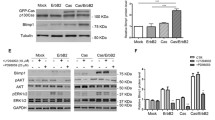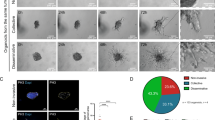Abstract
Inflammatory breast cancer (IBC) is the most deadly form of breast cancer in humans presumably due to its ability to metastasize from its inception. In our laboratory, overexpression of RhoC GTPase was observed to be specific for IBC tumors, but not for stage-matched, non-IBC tumors. RhoC is known to contribute to an IBC-like phenotype in HPV-E6E7 immortalized breast cells. To further study the effect of RhoC overexpression on IBC metastasis, we generated stable transfectants of spontaneous immortalized mammary epithelial cells (MCF10A) overexpressing wild-type RhoC or a constitutively active RhoC mutant (G14V). Both the RhoC wild type and the G14V transfectants were highly invasive and proliferated more rapidly compared to vector-only control clones. Overexpression of RhoC led to an increase in actin stress fiber and focal adhesion contact formation. Comparative microarray analysis of these clones further revealed that RhoC overexpression upregulated 108 genes whereas seven genes were down-regulated. We have further verified by quantitative RT-PCR that genes involved in cell proliferation, invasion/adhesion, and angiogenesis were modulated by RhoC. This work suggests strong candidates for the downstream oncogenic functions of RhoC.
Similar content being viewed by others
References
Jaiyesimi IA, Buzdar AU, Hortobagyi G: Inflammatory breast cancer: a review. J Clin Oncol 10: 1014–1024, 1992
Lee BJ, Tannenbaum NE: Inflammatory carcinoma of the breast: a report of twenty-eight cases from the breast clinic of Memorial Hospital. Surg Gynecol Obstet 39: 580–595, 1924
Merajver SD, Weber BL, Cody R, Zhang D, Strawderman M, Calzone KA, LeClaire V, Levin A, Irani J, Helvie M, August D, Wicha MS, Lichter A, Pierce LJ: Breast conservation and prolonged chemotherapy for locally advanced breast cancer: the University of Michigan experience. J Clin Oncol 15: 2873–2881, 1997
Swain SM, Sorace RA, Bagley CS, Danforth DN, Bader J, Wesley MN, Steinberg SM, Lippman ME: Neoadjuvant chemotherapy in the combined modality approach of locally advanced nonmetastatic breast cancer. Cancer Res 47: 3889–3894, 1987
van Golen KL, Davies S, Wu ZF, Wang Y, Bucana CD, Root H, Chandrasekharappa S, Strawderman M, Ethier SP, Merajver SD: A novel putative low-affinity insulin-like growth factorbinding protein, LIBC (lost in inflammatory breast cancer), and RhoC GTPase correlate with the inflammatory breast cancer phenotype. Clin Cancer Res 5: 2511–2519, 1999
van Golen KL, Wu ZF, Qiao XT, Bao LW, Merajver SD: RhoC GTPase, a novel transforming oncogene for human mammary epithelial cells that partially recapitulates the inflammatory breast cancer phenotype. Cancer Res 60: 5832–5838, 2000
Kleer CG, Zhang Y, Pan Q, van Golen KL, Wu ZF, Livant D, Merajver SD: WISP3 is a novel tumor suppressor gene of inflammatory breast cancer. Oncogene 21: 3172–3180, 2002
Ethier SP, Mahacek ML, Gullick WJ, Frank TS, Weber BL: Differential isolation of normal luminal mammary epithelial cells and breast cancer cells from primary and metastatic sites using selective media. Cancer Res 53: 627–635, 1993
Etienne-Manneville S, Hall A: Integrin-mediated activation of Cdc42 controls cell polarity in migrating astrocytes through PKCzeta. Cell 106: 489–498, 2001
Kamai T, Tsujii T, Arai K, Takagi K, Asami H, Ito Y, Oshima H: Significant association of Rho/ROCK pathway with invasion and metastasis of bladder cancer. Clin Cancer Res 9: 2632–2641, 2003
Horiuchi A, Imai T, Wang C, Ohira S, Feng Y, Nikaido T, Konishi I: Up-regulation of small GTPases, RhoA and RhoC, is associated with tumor progression in ovarian carcinoma. Lab Invest 83: 861–870, 2003
Suwa H, Ohshio G, Imamura T, Watanabe G, Arii S, Imamura M, Narumiya S, Hiai H, Fukumoto M: Overexpression of the rhoC gene correlates with progression of ductal adenocarcinoma of the pancreas. Br J Cancer 77: 147–152, 1998
Clark EA, Golub TR, Lander ES, Hynes RO: Genomic analysis of metastasis reveals an essential role for RhoC. Nature 406: 532–535, 2000
Soule HD, Maloney TM, Wolman SR, Peterson Jr WD, Brenz R, McGrath CM, Russo J, Pauley RJ, Jones RF, Brooks SC: Isolation and characterization of a spontaneously immortalized human breast epithelial cell line, MCF-10. Cancer Res 50: 6075–6086, 1990
Soule H, McGrath CM: Immortal human mammary epithelial cell lines. Primary Examiner: Kepplinger, Esther L. Assistant Examiner: Scheiner, Toni R. Attorney AoFK, Robert L. G, Dykema (eds). 317610[5,026,637]. 6–25–1991. Michigan/United States, Jones et al., Breast Cancer Res Group and Pathology Dept., Michigan Cancer Foundation, Detroit, MI, Proceedings of AACR, Vol. 29, March 1988
Kleer CG, van Golen KL, Zhang Y, Wu ZF, Rubin MA, Merajver SD: Characterization of RhoC expression in benign and malignant breast disease: a potential new marker for small breast carcinomas with metastatic ability. Am J Pathol 160: 579–584, 2002
Dhanasekaran SM, Barrette TR, Ghosh D, Shah R, Varambally S, Kurachi K, Pienta KJ, Rubin MA, Chinnaiyan AM: Delineation of prognostic biomarkers in prostate cancer. Nature 412: 822–826, 2001
Tusher VG, Tibshirani R, Chu G: Significance analysis of microarrays applied to the ionizing radiation response. Proc Natl Acad Sci USA 98: 5116–5121, 2001
Xiong Y, Connolly T, Futcher B, Beach D: Human D-type cyclin. Cell 65: 691–699, 1991
Zachary I: Signaling mechanisms mediating vascular protective actions of vascular endothelial growth factor. Am J Physiol Cell Physiol 280: C1375-C1386, 2001
Dhawan P, Richmond A: Role of CXCL1 in tumorigenesis of melanoma. J Leukoc Biol 72: 9–18, 2002
Couet J, Belanger MM, Roussel E, Drolet MC: Cell biology of caveolae and caveolin. Adv Drug Deliv Rev 49: 223–235, 2001
Danen EH, Yamada KM: Fibronectin, integrins, and growth control. J Cell Physiol 189: 1–13, 2001
Norton PA, Hynes RO: In vitro splicing of fibronectin premRNAs. Nucl Acids Res 18: 4089–4097, 1990
Moschos SJ, Mantzoros CS: The role of the IGF system in cancer: from basic to clinical studies and clinical applications. Oncology 63: 317–332, 2002
Polsky D, Cordon-Cardo C: Oncogenes in melanoma. Oncogene 22: 3087–3091, 2003
Sahai E, Marshall C: RHO-GTPases and Cancer. Nature Rev-Cancer 2: 133, 2002
van Golen KL, Bao L, Pan Q, Miller FR, Wu ZF, Merajver S: Mitogen activated protein kinase pathway is involved in RhoC GTPase induced motility, invasion and angiogenesis in inflammatory breast cancer. Clin Exp Metast 19: 301–311, 2002
Strieter RM, Belperio JA, Keane MP: CXC chemokines in angiogenesis related to pulmonary fibrosis. Chest 122: 298S-301S, 2002
Boudreau N, Bissell MJ: Extracellular matrix: the networking solution. In: Alison MA (ed) The Molecular Basis of Cell and Tissue Organisation. Nature Publishing Group, London, New York and Tokyo, 2002, pp 209–224
Dean DC, Newby RF, Bourgeois S: Regulation of fibronectin biosynthesis by dexamethasone, transforming growth factor beta, and cAMP in human cell lines. J Cell Biol 106: 2159–2170, 1988
Bhowmick NA, Ghiassi M, Bakin A, Aakre M, Lundquist CA, Engel ME, Arteaga CL, Moses HL: Transforming growth factor-beta1 mediates epithelial tomesenchymal transdifferentiation through a RhoA-dependent mechanism. Mol Biol Cell 12: 27–36, 2001
Edlund S, Landstrom M, Heldin CH, Aspenstrom P: Transforming growth factor-beta-induced mobilization of actin cytoskeleton requires signaling by small GTPases Cdc42 and RhoA. Mol Biol Cell 13: 902–914, 2002
Shen X, Li J, Hu PP, Waddell D, Zhang J, Wang XF: The activity of guanine exchange factor NET1 is essential for transforming growth factor-beta-mediated stress fiber formation. J Biol Chem 276: 15362–15368, 2001
Ellerbroek SM, Wennerberg K, Burridge K: Serine phosphorylation negatively regulates RhoA in vivo. J Biol Chem 278: 19023–19031, 2003
Razani B, Lisanti MP: Caveolin-deficient mice: insights into caveolar function human disease. J Clin Invest 108: 1553–1561, 2001
Campbell L, Gumbleton M, Ritchie K: Caveolae and the caveolins in human disease. Adv Drug Deliv Rev 49: 325–335, 2001
Engelman JA, Lee RJ, Karnezis A, Bearss DJ, Webster M, Siegel P, Muller WJ, Windle JJ, Pestell RG, Lisanti MP: Reciprocal regulation of neu tyrosine kinase activity and caveolin-1 protein expression in vitroand in vivo. Implications for human breast cancer. J Biol Chem 273: 20448–20455, 1998
Oh Y, Muller HL, Lamson G, Rosenfeld RG: Insulinlike growth factor (IGF)-independent action of IGF-binding protein-3 in Hs578T human breast cancer cells. Cell surface binding and growth inhibition. J Biol Chem 268: 14964–14971, 1993
Author information
Authors and Affiliations
Rights and permissions
About this article
Cite this article
Wu, M., Wu, ZF., Kumar-Sinha, C. et al. RhoC Induces Differential Expression of Genes Involved in Invasion and Metastasis in MCF10A Breast Cells. Breast Cancer Res Treat 84, 3–12 (2004). https://doi.org/10.1023/B:BREA.0000018426.76893.21
Issue Date:
DOI: https://doi.org/10.1023/B:BREA.0000018426.76893.21




